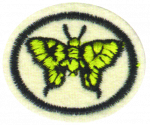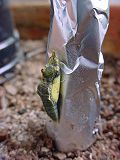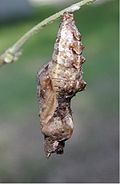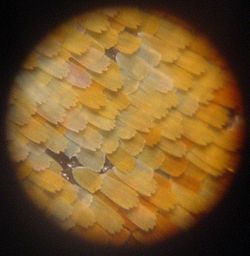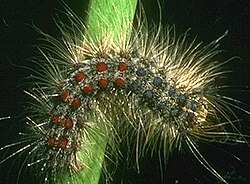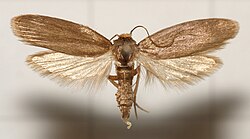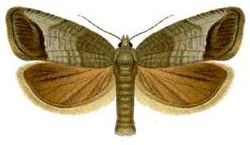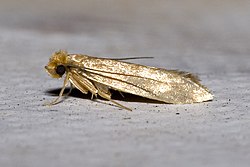Difference between revisions of "AY Honors/Moths & Butterflies/Answer Key/es"
(Created page with "</noinclude> <!-- 5. Nombrar tres palomillas perjudiciales a los árboles y una palomilla nociva a la casa y decir durante qué etapas de su vida ellas hacen sus daños. --> =...") |
(Created page with "Las polillas gitanas solamente comen durante su etapa larval. {{clear}} ====Orugas de tienda (''Malacosoma neustria'')==== Image:Western tent caterpillars Malacosoma califor...") |
||
| Line 85: | Line 85: | ||
La polilla gitana se introdujo en los Estados Unidos en 1868 por un científico francés, Leopold Trouvelot, quien vivía en New Bedford, Massachusetts. Las orugas de hilado de seda nativas estaban demostrando ser susceptibles a la enfermedad. Trouvelot trajo huevos de la polilla gitana para tratar de hacer un híbrido de oruga, que podría resistir enfermedades. Cuando algunas de las polillas se escaparon de su laboratorio, comenzaron a multiplicarse. Con el tiempo, llegaron a ser polillas gitanas como las conocemos hoy en día. Ahora es una de las plagas más notorias de árboles de madera dura en el oriente de los Estados Unidos. | La polilla gitana se introdujo en los Estados Unidos en 1868 por un científico francés, Leopold Trouvelot, quien vivía en New Bedford, Massachusetts. Las orugas de hilado de seda nativas estaban demostrando ser susceptibles a la enfermedad. Trouvelot trajo huevos de la polilla gitana para tratar de hacer un híbrido de oruga, que podría resistir enfermedades. Cuando algunas de las polillas se escaparon de su laboratorio, comenzaron a multiplicarse. Con el tiempo, llegaron a ser polillas gitanas como las conocemos hoy en día. Ahora es una de las plagas más notorias de árboles de madera dura en el oriente de los Estados Unidos. | ||
| − | + | Las polillas gitanas solamente comen durante su etapa larval. | |
| + | {{clear}} | ||
| + | ====Orugas de tienda (''Malacosoma neustria'')==== | ||
| + | [[Image:Western tent caterpillars Malacosoma californicum.jpg|thumb|200px|''Malacosoma neustria'']] | ||
| + | Las «orugas de tienda» son una especie de tamaño moderada del género ''Malacosoma'' en la familia polilla ''Lasiocampidae''. La especie se encuentra en Nortemérica y Eurasia. Veintiséis especies han sido descritas, seis de los cuales se producen en Nortemérica. Aunque la mayoría de la gente considera que las orugas de tienda como plagas debido a su hábito de deshojar los árboles, se encuentran entre las más social de todas las orugas y exhiben muchos comportamientos destacables. | ||
Gypsy moths eat only during their larval stage. | Gypsy moths eat only during their larval stage. | ||
Revision as of 20:37, 26 February 2021
| Mariposas | ||
|---|---|---|
| Asociación General
|
Destreza: 2 Año de introducción: 1933 |
|
Requisitos
|
La especialidad de Mariposas es un componente de la Maestría Naturaleza. |
|
La especialidad de Mariposas es un componente de la Maestría Zoología. |
| Conexión Logros para la Investidura: Esta especialidad está relacionada con los requisitos de Logros para la Investidura para VIAJERO AL AIRE LIBRE Estudio de la naturaleza que requiere (como una de dos opciones) dibujar, fotografiar o recolectar 10 especies de mariposas similar al requisito #7 de esta especialidad. El requisito #8 de esta especialidad es similar al requisito 1b de VIAJERO Estudio de la Estudio de la naturaleza. Esta especialidad es una elección popular para la especialidad de la categoría de Estudio de la naturaleza de nivel de destreza 2 o 3 requerido para los VIAJEROS AL AIRE LIBRE. |
1
La división de los lepidópteros en las polillas y las mariposas es una taxonomía popular, no una científica. Las distinciones aquí no son absolutas. Hay muchas mariposas con algunas de las características de las polillas y muchas polillas con algunas de las características de las mariposas.
Antena
La diferencia más obvia es en las antenas. La mayoría de las mariposas tienen antenas finas, delgadas y filamentosas que son en forma de porra en los extremos. Polillas, por otro lado, usualmente tienen antenas en forma de peine o plumosas, o filamentosas y no en forma de porra.
Las pupas
La mayoría de las orugas de la polilla tejen un capullo de seda dentro de los cuales se transforman en la fase de pupa. La mayoría de las mariposas, por otra parte, forman una pupa expuesta que se denomina como una crisálida.
Coloración de las alas
La mayoría de las mariposas tienen colores brillantes en sus alas. Las polillas nocturnas, por otro lado, suelen ser marrón, gris, blanco o negro, y con frecuencia con patrones oscuras de zigzag que ayudan a camuflarse cuando descansan durante el día. Sin embargo, muchas polillas diurnas son de colores brillantes, especialmente si son tóxicas. Algunas mariposas son también de color suave, como la blanquita de la col.
Hora de actividad
La mayoría de las polillas son nocturnas mientras la mayoría de las mariposas son diurnas. Sin embargo, hay excepciones, como la polilla gitana y el espectacular «Uraniidae» o la polillas crepuscular.
Postura de descanso
Las polillas normalmente descansan con sus alas extendidas a sus lados. Las mariposas frecuentemente pliegan sus alas por encima de la espalda cuando descansan, a pesar de que de vez en cuando «toman el sol» con sus alas extendidas por períodos cortos.
2
- a. Antenas
- Las antenas son apéndices emparejados conectados a los segmentos más adelante de un insecto. Las antenas son articuladas, al menos en la base, y en general se extienden hacia adelante de la cabeza. Son órganos de los sentidos, aunque la naturaleza exacta de lo que sienten y cómo perciben no es la misma en todos los grupos, ni siempre es clara. Las funciones pueden incluir diversos sentidos del tacto, de movimiento de aire, calor, vibraciones (sonido), y especialmente el olor o sabor.
- Capullo
- Un capullo es una carcasa de hilado de seda que hacen muchas orugas de la polilla y otras numerosas larvas de insectos como una cubierta protectora para la pupa.
- Pupa
- Una pupa es la etapa de la vida de algunos insectos en proceso de transformación.
- Larva
- Una larva es una forma juvenil de un animal con desarrollo indirecto, en proceso de metamorfosis (por ejemplo, insectos o anfibios). La larva puede parecerse totalmente diferente a la forma adulta; por ejemplo, una oruga se diferencia de una mariposa. Las larvas a menudo tienen órganos especiales (de larvas) que no se producen en la forma adulta.
- Crisálida
- Una crisálida o ninfa es la etapa de pupa de las mariposas. Debido a que las crisálidas son vistosas y se forman en pleno vista, son los ejemplos más conocidos de pupas. La mayoría de las crisálidas están unidas a una superficie mediante un arreglo parecido al de velcro como de una almohadilla de seda tejida por la oruga y un conjunto de ganchos en la punta del abdomen de pupa.
3
4
Este polvo está hecho de pequeñas escamas que cubren las alas de la mariposa. Estas escamas le dan a las alas su color, como la membrana por debajo de las escamas es casi transparente. Las escamas se desprenden cuando se frota por un dedo, tanto como la piel de la rodilla de una persona se desgasta cuando se raspa con la acera.
5
Polillas de árboles
Polilla gitana
La polilla gitana se introdujo en los Estados Unidos en 1868 por un científico francés, Leopold Trouvelot, quien vivía en New Bedford, Massachusetts. Las orugas de hilado de seda nativas estaban demostrando ser susceptibles a la enfermedad. Trouvelot trajo huevos de la polilla gitana para tratar de hacer un híbrido de oruga, que podría resistir enfermedades. Cuando algunas de las polillas se escaparon de su laboratorio, comenzaron a multiplicarse. Con el tiempo, llegaron a ser polillas gitanas como las conocemos hoy en día. Ahora es una de las plagas más notorias de árboles de madera dura en el oriente de los Estados Unidos.
Las polillas gitanas solamente comen durante su etapa larval.
Orugas de tienda (Malacosoma neustria)
Las «orugas de tienda» son una especie de tamaño moderada del género Malacosoma en la familia polilla Lasiocampidae. La especie se encuentra en Nortemérica y Eurasia. Veintiséis especies han sido descritas, seis de los cuales se producen en Nortemérica. Aunque la mayoría de la gente considera que las orugas de tienda como plagas debido a su hábito de deshojar los árboles, se encuentran entre las más social de todas las orugas y exhiben muchos comportamientos destacables.
Gypsy moths eat only during their larval stage.
Tent caterpillar
"Tent Caterpillars" are moderately sized species in the genus Malacosoma in the moth family Lasiocampidae. Species occur in North America and Eurasia. Twenty-six species have been described, six of which occur in North America. Although most people consider tent caterpillars only as pests due to their habit of defoliating trees, they are among the most social of all caterpillars and exhibit many noteworthy behaviors.
Tent caterpillars are readily recognized because they are social, colorful, diurnal and build conspicuous silk tents in the branches of host trees. Some species, such as the eastern tent caterpillar, Malacosoma americanum, build a single large tent which is typically occupied through the whole of the larval stage while others build a series of small tents that are sequentially abandoned. The forest tent caterpillar, Malacosoma disstrium, is exceptional in that the larvae build no tent at all, aggregating instead on silken mats that they spin on the leaves or bark of trees. Tents facilitate aggregation and serve as focal sites of thermal regulatory behavior. They also serve as communication centers where caterpillars are alerted to the discovery of new food finds.
Lesser wax moth
Wax moths were first seen in North America in 1806. People believe they came over with honeybees from Europe. The lesser wax moth is very common all over the world, except the colder regions. The larvae are the only ones that eat, the adults will not eat.
Their diet typically consists of honey, beeswax, stored pollen, bee shell casings, and, in some cases, bee brood. While tunneling through honeycombs attaining food, these moths are also protecting themselves from their main enemy, the honeybee.
Codling moth
Codling moths are known as an agricultural pest, their larva being the common apple worm or maggot. It is native to Europe and was introduced to North America, where it has become one of the regular pests of apple orchards. It is found almost worldwide. It also attacks pears, walnuts, and other tree fruits. This larva is the famous "worm in the apple" of cartoon and vernacular fame.
House Moths
Clothing Moth
The Clothing Moth (Tineola bisselliella) is a winged insect capable of flying, which develops from a caterpillar. It is recognized as a serious pest. Like most moth caterpillars, it can (and will) derive nourishment not only from clothing but also from many other sources.
Eggs hatch into larvae, which then begin to feed. Once they get their fill, they pupate and undergo metamorphosis to emerge as adults. Adults do not eat: male adults look for females and adult females look for places to lay eggs. Once their job is done, they die. Contrary to what most people believe, adult clothing moths do not eat or cause any damage to clothing or fabric. It is the larvae which are solely responsible for this, spending their entire time eating and foraging for food.
White-shouldered Moth
The White Shouldered House Moth (Endrosis sarcitrella) is a very common moth and occurs regularly inside buildings, and being continuously-brooded, can be found at any time of year, mainly found indoors via open doors, windows etc. It is a widely distributed species whose larvae infest stored grain
6
Monarch butterflies are especially noted for their lengthy annual migration. They make massive southward migrations starting in August until the first frost. A northward migration takes place in the spring. Female Monarchs deposit eggs for the next generation during these migrations. By the end of October, they reach their overwintering grounds. The length of these journeys exceeds the normal lifespan of most Monarchs, which is less than two months for butterflies born in early summer. The last generation of the summer enters into a non-reproductive phase known as diapause and may live up to 7 months. During diapause, butterflies fly to one of many overwintering sites. The generation that overwinters generally does not reproduce until it leaves the overwintering site sometime in February and March. It is thought that the overwinter population may reach as far north as Texas and Oklahoma during the spring migration. It is the second, third and fourth generations that return to their northern locations in the United States and Canada in the spring. How the species manages to return to the same overwintering spots over a gap of several generations is still a subject of research; the flight patterns appear to be inherited, based on a combination of circadian rhythm and the position of the sun in the sky.
7
- a. Nombre
- b. Fecha observada
- c. Ubicación
- d. Hora del día
- e. Planta con la cual el insecto fue alimentado y/o el material en el que se encontraba posado.
For identification purposes, you will need to get a copy of a good field guide. As with many other identification tasks, it is best to find a specimen first and then attempt to identify it, rather than going out to look for a particular specimen.
Pathfinders are encouraged to draw or photograph specimens rather than collect them. Identification should be done in the field. If going as a group, it is OK to bring one camera (perhaps the instructor's) and then have the rest of the participants make their drawing from the pictures taken. If you have access to a digital camera and a projector, you could project a slide show and have the Pathfinders make drawings as the slides are shown. You may also print the photos and pass them around.
for identifying them online here are some, http://www.insectidentification.org/butterflies-and-moths.asp
8
Butterflies and moths are notable for their unusual life cycle with a larval caterpillar stage, an inactive pupal stage, and a spectacular metamorphosis into a familiar and colorful winged adult form.
Life Cycle
Unlike many insects, butterflies do not experience a nymph period, but instead go through a pupal stage which lies between the larva and the adult stage. The four stages of a butterfly's life cycle are:
- Egg
- Butterfly eggs are fixed to a leaf with a special glue which hardens rapidly. As it hardens it contracts, deforming the shape of the egg. This glue is easily seen surrounding the base of every egg. Eggs are usually laid on plants. Each species of butterfly has its own hostplant range and while some species of butterfly are restricted to just one species of plant, others use a range of plant species, often including members of a common family.
- Caterpillar
- Larvae, or caterpillars, are multi-legged eating machines. They consume plant leaves and spend practically all of their time in search of food. Caterpillars mature through a series of stages, called instars. At the end of each instar, the larva moults the old cuticle, and the new cuticle rapidly hardens and pigments. Development of butterfly wing patterns begins by the last larval instar.
- Pupa
- When the larva is fully grown, hormones are produced. At this point the larva stops feeding and begins "wandering" in the quest of a suitable pupation site, often the underside of a leaf. The larva transforms into a pupa (or chrysalis) by anchoring itself to a substrate and moulting for the last time. The chrysalis is usually incapable of movement, although some species can rapidly move the abdominal segments or produce sounds to scare potential predators.
- Imago
- The adult, sexually mature, stage of the insect is known as the imago. After it emerges from its pupal stage, a butterfly cannot fly until the wings are unfolded. A newly-emerged butterfly needs to spend some time inflating its wings with blood and letting them dry, during which time it is extremely vulnerable to predators. Some butterflies' wings may take up to three hours to dry while others take about one hour.
Resurrection
The life cycle of the butterfly has parallels to the life cycle of a Christian. During the larval stage, a butterfly lacks the beauty of an adult. It spends all of its time feeding itself, often causing major damage to plants. This stage of a butterfly's life can be likened to the untranslated state of man, in that it is unlovely and often ignorant of the damage it causes.
Eventually, the caterpillar pupates. This stage is parallel to death.
While inside its chrysalis, the butterfly is transformed. This is not something it is conscious of doing. At the resurrection of the righteous, the Christian will also transformed by Christ into a new person, free from all defects. Gone are the selfish desires and the ugliness. It is a beautiful creature free from sin.
References
New and Used Field Guides at Amazon
- Categoría: Tiene imagen de insignia
- Adventist Youth Honors Answer Book/Honors/es
- Adventist Youth Honors Answer Book/es
- Adventist Youth Honors Answer Book/Skill Level 2/es
- Categoría: Libro de respuestas de especialidades JA/Especialidades introducidas en 1933
- Adventist Youth Honors Answer Book/General Conference/es
- Adventist Youth Honors Answer Book/Nature/es
- Adventist Youth Honors Answer Book/Nature/Primary/es
- Adventist Youth Honors Answer Book/Stage 100/es
- Adventist Youth Honors Answer Book/Naturalist Master Award/Fauna/es
- Adventist Youth Honors Answer Book/Zoology Master Award/Fauna/es
- Adventist Youth Honors Answer Book/IAConnection/es
- Adventist Youth Honors Answer Book
